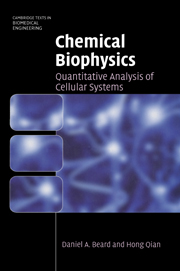Book contents
- Frontmatter
- Contents
- Preface
- Introduction
- Part I Background material
- Part II Analysis and modeling of biochemical systems
- Part III Special topics
- 8 Spatially distributed systems and reaction–diffusion modeling
- 9 Constraint-based analysis of biochemical systems
- 10 Biomacromolecular structure and molecular association
- 11 Stochastic biochemical systems and the chemical master equation
- 12 Appendix: the statistical basis of thermodynamics
- Bibliography
- Index
8 - Spatially distributed systems and reaction–diffusion modeling
Published online by Cambridge University Press: 05 June 2012
- Frontmatter
- Contents
- Preface
- Introduction
- Part I Background material
- Part II Analysis and modeling of biochemical systems
- Part III Special topics
- 8 Spatially distributed systems and reaction–diffusion modeling
- 9 Constraint-based analysis of biochemical systems
- 10 Biomacromolecular structure and molecular association
- 11 Stochastic biochemical systems and the chemical master equation
- 12 Appendix: the statistical basis of thermodynamics
- Bibliography
- Index
Summary
Overview
Previous chapters have treated cells – or cellular organelles such as mitochondria – as well-mixed bags of reacting biochemical components, without accounting for spatial heterogeneities in the concentrations of reacting species. This well-mixed-compartment approximation is indeed an appropriate assumption for certain applications. However, it is clear that intracellular concentration gradients exist. For example, the intracellular transport of oxygen, like that of many important species, is driven by diffusion. Diffusion is driven by concentration gradients. Thus, for oxygen to be transported from the outside of a cell to sites of oxidative phosphorylation, significant intracellular gradients must exist.
This chapter introduces the concept of reaction–diffusion modeling – that is, modeling of coupled diffusion and reaction of chemical species. Following a brief overview of the mathematics of diffusion, classical models of oxygen transport to tissue are explored. Studying these analytically tractable models will provide the reader with the basic tools for modeling and analysis of spatially distributed transport of other species. Although a major focus is placed on oxygen transport, general models for transport and exchange between blood and tissue regions of solutes are developed. For more complex models, the focus here is on establishing appropriate governing equations without going into the details of numerical methods for simulations. The final section of this chapter provides a survey of applications in three-dimensional modeling of transport in biological systems.
- Type
- Chapter
- Information
- Chemical BiophysicsQuantitative Analysis of Cellular Systems, pp. 195 - 219Publisher: Cambridge University PressPrint publication year: 2008



